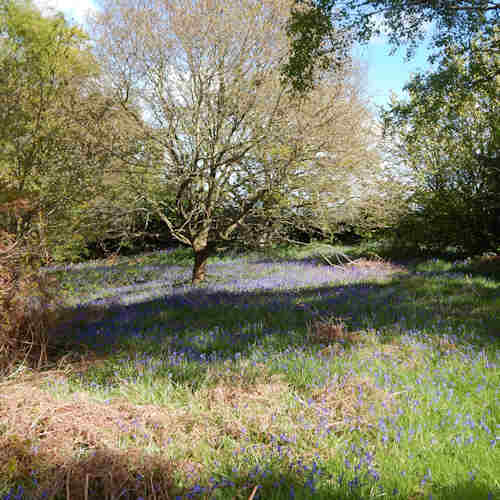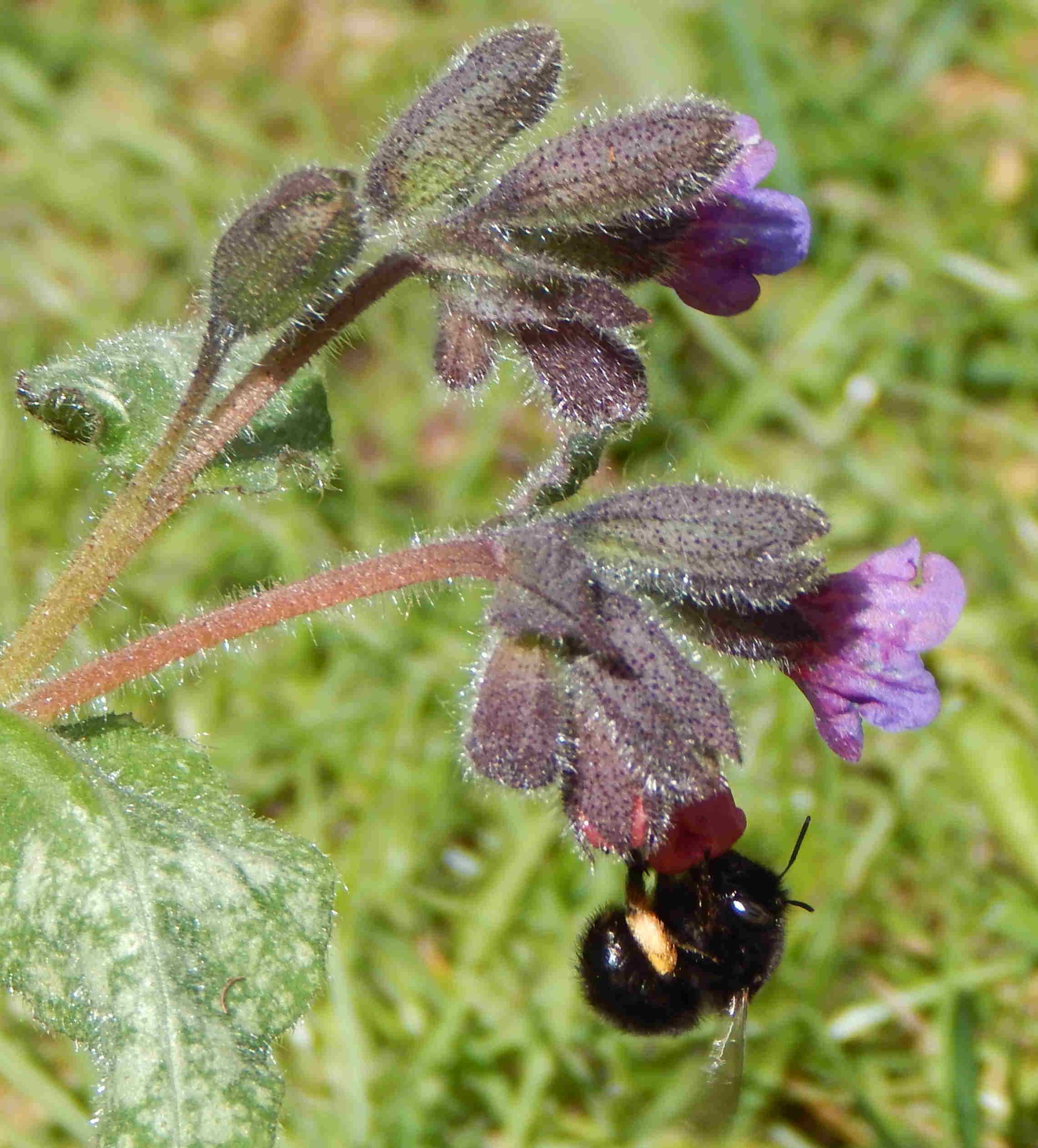Shade Garden Plants
For Bees
Which are the best plants for bees in a shade garden? What can you grow for bees and pollinators in such challenging conditions?
Many gardens have a few shady patches here and there, and the same is true of my garden, some of which are also quite dry.
Planting flowers in shade gardens - nature has the answers - of course!
Although it seems pollinators prefer foraging in sunshine, a shade garden can provide a number of opportunities for wildlife, including bees, particularly if the shade is caused by hedgerows or trees.
To an extent, wooded areas can also provide their own set of opportunities for some bee species. Much depends on the depth of the shade.
Shade can sometimes provide the right conditions for a bumble bee nest. Have you ever noticed bumble bees flying against the windows of your house, investigating dark shady spots beneath the garden shed, hovering around dark holes in the lawn?
So if you have shade in your garden, don't despair! In short, we have to make the best of our situation. This was the conclusion I came to, so I looked to nature for evidence that gardening with shade and attracting bees is possible.
 To an extent, wooded areas can provide their own set of opportunities for some bee species.
To an extent, wooded areas can provide their own set of opportunities for some bee species. Bluebells in the woodland close to my home. There are quite a few bees in this woodland, despite the shady areas.
Bluebells in the woodland close to my home. There are quite a few bees in this woodland, despite the shady areas.
Please note, do check suitability for planting in your country and region (for example, to ensure they are not considered invasive in your area), and as with all plants, check for toxicity if you have pets or children.
Flowers to attract bees in a shady area of the garden
English bluebells
English bluebells are attractive to bumble bees and a variety of solitary species. The will tolerate a fair amount of shade and are beautifully fragrant.

Hardy geraniums
I have found hardy geraniums to be useful in a fairly shaded area, and they seem to tolerate quite dry conditions. Geraniums are attractive to a range of bees, including honey bees, solitary and bumble bee species.
Look out for varieties that can thrive in full shade, such as Knotted cranesbill, Geranium nodosum and Dusky cranesbill 'Lily Lovell', Geranium phaeum 'Lily Lovell'.
 Leafcutter bee visiting Geranium
Leafcutter bee visiting GeraniumCommon foxglove - Digitalis purpurea
In my experience, Foxgloves (I have the common foxglove, Digitalis purpurea) are so attractive to bees that the shade never seems to put them off. Indeed, when they were in full bloom, it was probably the busiest part of my garden where the bees are concerned.
 Bumble bees cannot resist the common foxglove, Digitalis purpurea.
Bumble bees cannot resist the common foxglove, Digitalis purpurea.Bell flower (bedding plant) - Campanula
There are many wonderful varieties of Campanula (bell flower), and an abundance of bees that will forage upon them.
I have had 3 different types of low growing, spreading Campanula in the past, and all have been a hit with the bees. I still have quite a few patches, much of it growing in the shade, and some of it filling nooks and crannies around walls and pavements. I commonly see honey bees, leafcutters, mason and bumble bees foraging on it.
Bedding campanulas can spread quite rapidly. Can also thrive in wall crevices.
For a tall Campanula that can thrive in partial shade, consider Fairy bellflower - Campanula persicifolia.
 Honey bee on bell-flower Campanula in a shady part of the garden.
Honey bee on bell-flower Campanula in a shady part of the garden.Crocuses and other spring bulbs and corms
Don't forget about spring bulbs:
- crocuses,
- carefully selected daffodil varieties, and
- snowdrops look beautiful planted in swathes around wooded and shady areas - see my page about snowdrops.
 Mason bee inside a Crocus flower
Mason bee inside a Crocus flowerLungwort - Pulmonaria 'Blue Ensign'
Lungwort is fabulous for bees, especially during later winter through to early spring, when when availability of nectar and pollen rich flowers is limited.
The flowers on this low-growing perennial plant are a lovely pinkish, blue, and the leaves are mottled, adding interest to shade areas even when not in flower.
Oh, and this plant is a firm favourite with Hairy-footed Flower Bees!
 Hairy-footed flower bee female, on Lungwort.
Hairy-footed flower bee female, on Lungwort.Astrantia - Masterwort
This flower is lovely in a border and attracts many pollinators. Look out for varieties to suit the growing position. For example Astrantia helleborifolia, is known to thrive in full shade.
 Astrantia
AstrantiaWild garlic / ramsons - Allium ursinum
As stated earlier, flowers that grow in woodlands are generally well adapted to cope with at least some shade. If you have a wooded area in your garden, wild garlic (otherwise known as 'ramsons') - Allium ursinum, is a lovely herb, and would be a great choice.
Visited by a variety of bee species, including mason bees.
 Red Mason bee on wild garlic - a flower commonly seen around woodlands
Red Mason bee on wild garlic - a flower commonly seen around woodlandsOne year, I spent about 15 minutes around a small patch of wild garlic in a wooded area, and saw many bee species. Anyway, within about 15 minutes I saw mason bees, various nomad species, mining bees, and honey bees.
Note, if you grow a lot of it, Ransoms are quite pungent when in flower. I rather like it - for me it's a cross between the garlic bulbs we eat, onions and sage, and apparently, the leaves are edible.
Ivy - Hedera helix
In some regions of the world, this plant is considered invasive, and should be kept out of the garden. Elsewhere, this is a useful climbing shrub that could hugely enhance opportunities for bees and other wildlife, if grown over a wall. (It could, however, ultimately be detrimental if climbing up a tree).
Late foraging bees will benefit from Hedera helix, in particular, the Ivy bee, Colletes hedera.
 Ivy bee, Colletes hedera, male
Ivy bee, Colletes hedera, maleHolly - Ilex
The inconspicuous flowers of holly trees are literally a magnet for many types of bees.
You have to ensure you select wisely to ensure plenty flowers (which of course, will be followed by berries the birds will be grateful for!).
 Honey bee on Holly flower
Honey bee on Holly flowerOregon grape - Mahonia
Helpful for bees and useful winter flowering shrubs.
 Honey bees on Mahonia
Honey bees on MahoniaOther shade / partial shade tolerant plants that are attractive to bees include:
- Cohosh bugbane / black snakeroot - Actaea racemosa
- Plantain lily - Hosta
- Turkish sage - Phlomis russeliana
- Deam's coneflower - Rudbeckia fulgida var. deamii
- Guelder rose - Viburnum opulus
- Rhododendron
 Honey bee foraging on Rhododendron
Honey bee foraging on Rhododendron
Hope you found these idea encouraging and helpful. There are possibilities, though you may have to experiment a little. Good luck!
More articles about bees and plants
- Bees And Brambles: The Value Of Brambles To Bees Also known as blackberry bush, research shows each bramble flower secretes lots of nectar for bees!
- Bees And Bee Balm Bee Balm (Monarda) - also known as 'Bergamot) is a herbaceous perennial which is attractive for bees.
- 30 Fantastic Garden Flowers For Bees Flowering plant recommendations for the perfect bee garden.
- Bees love lupins – but so do slugs and snails, so what can you do? Here's a way to protect your lupins....using garlic!
- Plant Oregano For Bees (Marjoram) It's rich in nectar, and attracts bees, butterflies and hoverflies in summer. Here's how to plant it.
- Fennel Pollen And Nectar Bees love fennel! How to grow it, gather it, and the many uses of fennel seeds and pollen.
